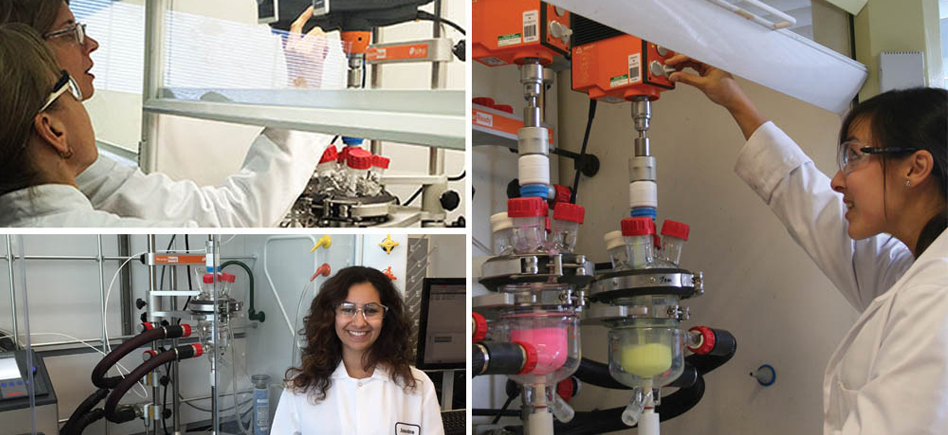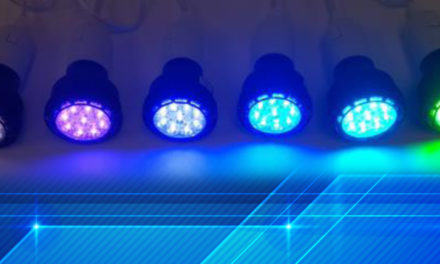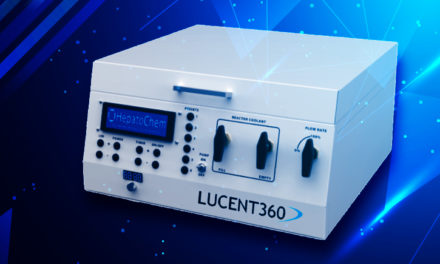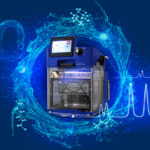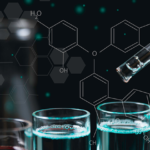Glass single or vacuum vessels are essential for chemical synthesis and process development. They allow to discover, synthesis way, to explore conditions, to optimize parameters…
These vessels must meet specific technical requirements such as the sealing because for some applications, the use of vacuum is needed. For example, it avoids working at high temperatures or to remove oxygen that which leads the formation of by-products.
In addition to this, for safety reasons and to allow users to achieve as many applications as possible, glass vessels must resist at minimum pressure.
To answer to these demanding needs, Interchim offers a unique and innovative range of jacketed reaction systems:
| The Reactor-Ready | The Reactor-Ready Duo | The Reactor-Ready Pilot |
 |
 |
 |
| More info | More info | More info |
These three systems meet technical requirements thanks to specific specification. They guarantee an excellent sealing for optimum vacuum and pressure levels.
To check that, factors influencing the vacuum in a lab reactor and tests to confirm the level of vacuum and pressure holding of the Ready-Ready are described below.
1. Factors influencing vacuum in a Ready synthesis reactor and our solutions:
A number of factors can affect the vacuum level that we can achieve in jacketed lab reactor.
a. Caps on the glass joints of the lid:
 |
To improve vacuum, it is strongly recommended to use glass cone stoppers rather than Rodaviss sealing caps on the in glass joints of the lid. |
 |
A common problem when using Rodaviss sealing caps is that the internal seal can be sucked out by the vacuum. Glass cone stoppers do not experience this issue, and are more chemically resistant too. |
b. O-rings:
All the O-ring (between the lid and the vessel, of the bottom valve, in the stirring guide…) must be cleaned and always in good condition. They must be changed regularly.

c. Positioning and good contition of the stirrer guide and the stirrer shaft:
 |
The stirrer guide and the stirrer shaft must be positioned correctly and are always in good condition. |
d. Vessel clamp:
 |
The vessel clamp for closing the vessel and the lid should be perfectly tightened. |
e. Moisture in the system:
Make sure there is no moisture in the system, which can increase the pressure and reduce the vacuum.
f. Vacuum (or silicone) grease:
Vacuum (or silicone) grease in glass joints can be used for improved vacuum level.
g. Vacuum pump:
A vacuum pump suitable for the application must be used.
If the vacuum pump or tubing is new, allow the experiment to run for a few hours to achieve the best vacuum levels.
h. Other factors that could also affect the vacuum level:
The reaction medium, the stirring speed, the temperature can also have an influence on quality of the vacuum.
As we can see, the influence of various factors as the feature of the reactor, its accessories, the vacuum pump and the parameters of the synthesis do have an influence on the sealing and consequently on the achievement of good vacuum and pressure levels. There must be no omissions in this regard.
The Reactor-Ready series of jacketed reactors have been specially designed to give improved performance compared to traditional systems, and one of these improvements is in vacuum/pressure tightness.

We can typically achieve a vacuum of around 10-20 mbar, but 3-5 mbar can be obtained under specific test conditions.
To confirm the achievement of these values, the following sealing tests were performed on the Reactor-Ready:
2. Sealing tests on the Reactor-Ready:
a. Vacuum testing:

Parts required:
- Reactor-Ready – including vessel, lid, PTFE support collar and O-ring, piston, stirrer guide, stirrer shaft, Pt100 and Pt100 adapter.
- Suitable vacuum pump; for example, Vacuubrand MD1C Vario pump with CVC controller.
- Suitable vacuum tubing 18mm OD x 8mm ID.
- Glass cone stoppers of appropriate sizes:
– 2 x RR139027 Glass Cone Stopper B19 (for lid port and bottom outlet valve (BOV) run-off).
– 2 x RR139029 Glass Cone Stopper B24(for lid ports).
– 1 x RR139031 Glass Cone Stopper B29 (for lid port).
– 1 x RR139033 Glass Cone Stopper B34 (for lid port).
N.B. not need of a glass cone stopper for the lid port where will be inserting the adapter for vacuum tubing into. - Right angle adapter (or gas purge adapter) to fit into a lid port to connect to vacuum tubing, RR139011 Right Angle Adapter B29 + GL14 + PTFE fittings are used.
- GL25 cap to seal BOV in place of piston, RR139117 Screw Cap Closed with PTFE Seal GL25 (Pack of 10) are used.
- Vacuum (silicone) grease.
Method:
- Ensure all items are clean, completely dry, and not damaged.
- Place vessel in Reactor-Ready framework, with collar/O-ring, lid and clamp in place.
- Insert right angle adapter into port on lid. Connect vacuum tubing between this and the vacuum pump.
- Insert glass cone stoppers into all remaining lid ports, using vacuum grease on the joints.
- Do not insert piston into vessel at this stage. Insert glass cone stopper (with vacuum grease) into BOV run-off. In place of piston, add the GL25 screw cap.
- The set-up should look like the photo shown on the previous page.
- Start the vacuum pump. Wait for it to reach the best possible vacuum. Record the vacuum level.
- Stop the vacuum pump and carefully release the vacuum. Next, remove the screw cap from the BOV, and insert the piston. Re-connect the vacuum tubing and start the vacuum pump. Wait for the pressure to decrease until the vacuum level plateaus. Record the value.
- Repeat step above, but this time add a stirrer guide and stirrer shaft to the lid. (Keep the piston in place.)
- Repeat step above, but this time add a Pt100 with appropriate adapter. Make sure the section of the Pt100secured in the adapter is straight not bent, to ensure a good seal. (Keep the piston and stirrer guide/shaft in place.).
- Check the leak rate by switching off the vacuum pump and observing how much the vacuum level changes in 1 minute..
Results:
The Reactor-Ready reaction vessels are typically expected to achieve around 10 mbar.
However, in previous testing, with all accessories in place as described above, Radleys have achieved approximately 3-5 mbar, with a leak rate of about 5 mbar/min.
b. Vacuum testing:

Parts required:
- Reactor-Ready – including vessel, lid, PTFE support collar and O-ring, piston, stirrer guide, stirrer shaft, Pt100 and Pt100 adapter.
- Suitable manometer (pressure gauge), such as Digitron 2082P Manometer.
- Manual pressure pump; we use 2911 Gauge Handpump from DRUCK & TEMPERATUR Leitenberger.
- Tubing suitable for slight positive pressure, nylon tubing 6mm OD x 4mm ID part no is used.
- T piece for connecting tubing to pressure pump, manometer and lid fitting.
- Glass cone stoppers of appropriate sizes:
– 2 x RR139027 Glass Cone Stopper B19 (for lid port and bottom outlet valve (BOV) run-off).
– 2 x RR139029 Glass Cone Stopper B24 (for lid ports).
– 1 x RR139031 Glass Cone Stopper B29 (for lid port).
– 1 x RR139033 Glass Cone Stopper B34 (for lid port).
N.B. Not need a glass cone stopper for the lid port will be inserting the adapter for tubing into. - Right angle adapter (or gas purge adapter) to fit into a lid port to connect to pressure tubing: RR139011 Right Angle Adapter B29, plus Bohlender GL15 compression fitting (in place of the usual GL14 hose barb).
- GL25 cap to seal BOV in place of piston : one from RR139117 Screw Cap Closed with PTFE Seal GL25 (Pack of 10) was used.
- Vacuum (silicone) grease.
Method:
- Ensure all items are clean, completely dry and not damaged.
- Place vessel in Reactor-Ready framework, with collar/O-ring, lid and clamp in place.
- Insert right angle adapter into port on lid. Connect tubing to this and the Tpiece. Connect the T-piece to the manometer (pressure gauge) and the hand pressure pump. This is shown inthe photo on the right.
- Insert glass cone stoppers into all remaining lid ports, using vacuum grease on the joints.
- Do not insert piston into vessel at this stage. Insert glass cone stopper (with vacuum grease) into BOV run-off. In place of piston, add the GL25 screw cap.
- Pump the hand pump until the pressure is at 500 mbar (i.e. 0.5 barg), our recommended maximum pressure for glassware. Wait to see whether the pressure holds. It may drop a few mbar initially, but it should then stabilise.
- Carefully release the pressure (via pressure relief valve on hand pump). Next, remove the screw cap from the BOV, and insert the piston. Repeat step below.
- Repeat step above, but this time add a stirrer guide and stirrer shaft to the lid. (Keep the piston in place.)
- Repeat step above, but this time add a Pt100 with appropriate adapter. Make sure the section of the Pt100 secured in the adapter is straight not bent, to ensure a good seal. (Keep the piston and stirrer guide/shaft in place.)
Results:
With all accessories in place as described above, the pressure should be stable at around 500 mbar, with no (obvious) leak rate.
If the addition of an accessory introduces an air leak, examine that item to try to identify why it has caused a leak.
c. Conclusion:
As we can see, the optimal sealing of the Reactor-Ready makes it possible to achieve good vacuum and pressure levels.
These results are also valid for the Reactor-Ready Duo and the Reactor-Ready Pilot because they are designed according to the same concept.
In addition to improved vacuum level, the improved sealing in Reactor-Ready series of jacketed reactors, means the equipment lasts longer because it is less likely to be corroded, less of the valuable product is lost, and the reactor is safer to use.
Know more:
- For more information about the Ready range, contact our experts who will be able to advise you.
Interchim® is the representative for Radleys in France, Germany and Austria.

